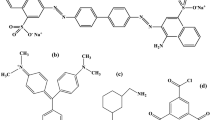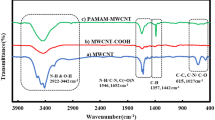Abstract
The removal of toxic metal ions using modified cellulose acetate (CA) membranes from aqueous solutions has been systematically investigated. CA ultrafiltration membranes were prepared by the phase inversion technique, using high performance thermoplastic poly (ether-ether-sulfone) (PEES) as the modification agent and polyethylene glycol (PEG-600) as the pore former. Toxic heavy metal ions, such as copper, nickel, zinc and cadmium, were subjected to separation by the blend membranes by complexing them with the polymeric ligand polyethyleneimine (PEI). The fouling resistant ability of the membranes was evaluated by bovine serum albumin (BSA) as a model foulant and flux recovery ratio and flux decline rate were calculated. The effects of different proportions of PEES (0–30 wt %) incorporated into the CA on the morphology, hydrophilicity, compatibility, degree of crystallinity, fouling propensity and toxic metal ions separation of the prepared membranes, were evaluated. The surface chemistry of the membranes was assessed by the attenuated total reflectance Fourier transform infrared spectroscopy (ATR-FTIR). Ultrafiltration characterisations, such as compaction, pure water flux (PWF), water content, membrane hydraulic resistance, porosity and molecular weight cut-off (MWCO) were investigated. Attempts have been made to correlate the performances of the membranes with their morphology. The scanning electron microscopy (SEM) studies revealed that the incorporation of PEES resulted in the formation of a spongy sub-layer, and increased the connectivity of pores between the sub-layer and the bottom layer. It is worth mentioning that the separation efficiency of these membranes arising from the fine dispersion of PEES in the CA matrix, obviously offers immense potential in industrial separations. Thus, it was found that the CA/PEES blend ultrafiltration membranes demonstrated better performance, compared to the membranes prepared from pure cellulose acetate.










Similar content being viewed by others
References
Van der Bruggen B, Curcio E, Drioli E (2004) Process intensification in the textile industry: the role of membrane technology. J Environ Manage 73:267–274
Saji J, Presada Rao T, Ramamohan TR, Reddy MLP (1999) Studies on the liquid–liquid extraction of iron(III) and titanium(IV) with 3-phenyl-4- benzoyl-5-isoxazolone. Talanta 50:1065–1071
Chen GH (2004) Electrochemical technologies in wastewater treatment. Sep Purif Technol 38:11–41
Berber Mendoza MS, Leyva Ramos R, Alonso Davila P, Fuentes Rubio L, Guerrero Coronado RM (2006) Comparison of isotherms for the ion exchange of Pb (II) from aqueous solution onto homoionic clinoptilolite. J Colloid Interface Sci 301:40–45
El Samrani AG, Lartiges BS, Villiéras F (2008) Chemical coagulation of combined sewer overflow: heavy metal removal and treatment optimization. Water Res 42:951–960
Fu F, Wang Q (2011) Removal of heavy metal ions from wastewaters: A review. J Environ Manage 92:407–418
Peinemann KV, Ebert K, Hicke HG, Scharnagl N (2004) Polymeric Composite Ultrafiltration Membranes for Non-aqueous Applications. Environ Prog 20:17–22
Baker RW (2000) Membrane technology and applications, 2nd edn. McGraw-Hill, New York
Geckler KE, Volchek K (1996) Removal of hazardous substances from water using ultrafiltration in conjunction with soluble polymers. Environ Sci Technol 30:725–734
Kuo SW (2008) Hydrogen-bonding in polymer blends. J Polym Res 15:459–486
Susanto H, Ulbricht M (2009) Characteristics, performance and stability of polyethersulfone ultrafiltration membranes prepared by phase separation method using different macromolecular additives. J Membr Sci 327:125–135
Cheryan M (1986) Ultrafiltration handbook. Technomic Publications, Lancaster
Lv C, Su Y, Wang Y, Ma X, Sun Q, Jiang Z (2007) Enhanced permeation performance of cellulose acetate ultrafiltration membrane by incorporation of Pluronic F127. J Membr Sci 294:68–74
Benosmane N, Guedioura B, Mohammed Hamdi S, Hamdi M, Boutemeur B (2010) Preparation, characterization and thermal studies of polymer inclusion cellulose acetate membrane with calix[4]resorcinarenes as carriers. Mater Sci Eng C 30:860–867
Idris A, Ahmed I, Jye HW (2008) Performance of cellulose acetate—polyethersulphone blend membrane prepared using microwave heating for palm oil mill effluent treatment. Water Sci Technol 56:69–77
Wang Q, Chen X, Zhang J, Pei Y (1997) Study on cellulose-based blend membranes. 1: Compatibility of cellulose acetate–polyacrylonitrile blend membrane. Polym Advan Technol 8:712–716
Saljoughi E, Mohammadi T (2009) Celluloseacetate (CA)/polyvinylpyrrolidone (PVP) blend asymmetric membranes: Preparation, morphology and performance. Desalination 249:850–854
Li J, Nagai K, Nakagawa T, Wang S (1995) Preparation of polyethyleneglycol (PEG) and cellulose acetate (CA) blend membranes and their gas permeabilities. J Appl Polym Sci 58:1455–1463
Sivakumar M, Malaisamy R, Sajitha CJ, Mohan D, Mohan V (2000) Preparation and performance of Cellulose Acetate–polyurethane blend membrane and their applications. II. J Membr Sci 169:215–228
Nagendran A, Vijayalakshmi A, Arockiasamy DL, Shobana KH, Mohan D (2008) Toxic metal ion separation by cellulose acetate/sulfonated poly(ether imide) blend membranes: effect of polymer composition and additive. J Hazard Mater 155:477–485
Wang Z, Li X, Zhao C (2007) Sulfonated poly(ether ether sulfone) copolymers for proton exchange membrane fuel cells. J Appl Polym Sci 104:1443–1450
Mauritz KA, Ju R (1994) Poly[(ether ether sulfone)-co-(ether sulfone)]/Silicon Oxide Microcomposites Produced via the Sol–gel Reaction for Tetraethylorthosilicate. Chem Mater 12:2269–2278
Mockel D, Staude E, Guiver MD (1999) Static protein adsorption, ultrafiltration behaviour and cleanability of hydrophilized polysulfone membranes. J Membr Sci 158:63–75
Murphy D, Pinho D (1995) An ATR-FTIR study of water in cellulose acetate membranes prepared by phase inversion. J Membr Sci 106:245–257
Badgley W, Frilette VJ, Mark H (1945) Cellulose and cellulose plastics: recent progress in cellulose chemistry. Ind Eng Chem 37:226–232
Baker WO (1945) Interchain order and orientation in CELLULOSE ESTERS. Ind Eng Chem 37:246–254
Segal L, Creely JJ, Martin AE Jr, Conrad CM (1962) An empirical method for estimating the degree of crystallinity of native cellulose using the x-ray diffractometer. Tex Res J 29:786–794
Ma X, Hu C, Guo R, Fang X, Wu H, Jiang Z (2008) HZSM5-filled cellulose acetate membranes for pervaporation separation of methanol/MTBE mixtures. Sep Purif Technol 59:34–42
Wienk IM, Boom RM, Beerlage MAM (1996) Recent advances in the formation of phase inversion membranes made from amorphous or semi-crystalline polymers. J Membr Sci 113:361–371
Smolders CA, Reuvers AJ, Boom RM (1992) Microstructures in phase inversion membranes. Part 1. Formation of macrovoids. J Membr Sci 73:259–275
Matsuura T, Matsuura M (1993) Synthetic Membranes and Membrane Separation Processes, CRC Press
Anadao P, Sato LF, Wiebeck H, Valenzuela-Diaz FR (2010) Montmorillonite as a component of polysulfone nanocomposite membranes. Applied Clay Science 48:127–132
Wang FG, Yang YY, Zhang XZ, Zhu X, Chung TS, Moochhala S (2002) Cellulose acetate membranes for transdermal delivery of scopolamine base. Mater Sci Eng C 20:93–100
Lizymol PP, Thomas S (1993) Thermal behaviour of polymer blends: a comparison of thermal properties of miscible and immiscible systems. Polym Degrad Stab 41:59–64
Persson KM, Gekas V, Tragardh G (1995) Study of membrane compaction and its influence on ultrafiltration water permeability. J Membr Sci 100:155–162
Rahimpour A, Madaeni S (2007) Polyethersulfone (PES)/cellulose acetate phthalate (CAP) blend ultrafiltration membranes: Preparation, morphology, performance and antifouling properties. J Membr Sci 305:299–312
Geckeler K, Lange G, Eberhardt H, Bayer E (1980) Preparation and application of water-soluble polymer- metal complexes. Pure & Appl Chem 52:l883–l1905
Majzlik P, Strasky A, Adam V, Nemec M, Trnkova L, Zehnalek J, Hubalek J, Provaznik I, Kizek R (2011) Influence of Zinc(II) and Copper(II) Ions on Streptomyces bacteria revealed by electrochemistry. Int J Electrochem Sci 6:2171–2191
Molinari R, Gallo S, Argurio P (2004) Metal ions removal from wastewater or washing water from contaminated soil by ultrafiltration–complexation. Water Res 38:593–600
Acknowledgement
The authors gratefully acknowledge the financial support from the Defence Research and Development Organisation (DRDO) New Delhi, India.
Author information
Authors and Affiliations
Corresponding author
Rights and permissions
About this article
Cite this article
Maheswari, P., Barghava, P. & Mohan, D. Preparation, morphology, hydrophilicity and performance of poly (ether-ether- sulfone) incorporated cellulose acetate ultrafiltration membranes. J Polym Res 20, 74 (2013). https://doi.org/10.1007/s10965-013-0074-z
Received:
Accepted:
Published:
DOI: https://doi.org/10.1007/s10965-013-0074-z




